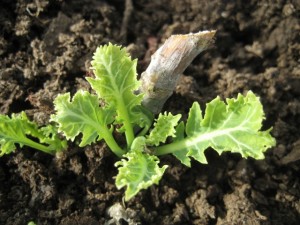I don’t like kale. In any way. Really. But it is so good for you, so nutritious, so health promoting, that I sneak it into every dish I can. And we never taste it!
I just went out to uncover my Square Foot Garden, since the sun finally decided to shine! In the fall, you put your Square Foot garden “to bed” for the winter by removing all the dead stuff and laying a blanket on top, secured by bricks, logs, stones, or whatever you have. This prevents weed seeds from blowing in, and also gives a little protection. My kale plants were green and lush at autumn’s end, but I knew our very cold winters would do them in. Rather than pulling them out, I laid the blanket loosely on top of them just to see what would happen. When I removed the blanket today, to my surprise little kale leaves were sprouting from the big old dead stalk. That kale is amazing! It seems to grow in the worst conditions and be happy about it, too!

A good time to plant kale is while it is still too cold for other plants. Buy a packet of seeds—it will last you for many seaons. A little kale goes a long way! Choose Russian Kale (flat leaf) rather than Curly Kale for the home garden. Easier to wash and no hiding places in the ruffles for bugs. You can continue to plant kale all summer long, and a nip of frost only sweetens the taste. Kale isn’t picky about soil type. Just shake the seeds down in a patch of your garden. I don’t plant in a row, I just scratch the surface of a square foot area and shake them on like salt. When kale is a small seedling, I harvest it with scissors and put it in salad, leaving a few well-spaced plants to mature further. From these growing plants, I remove leaves for use regularly. At summer’s end, the kale leaves are giant, but great for putting in my food dehydrator for use over the winter. If you are inclined, kale can even be harvested frozen! Kale is a coarser leaf, so it can be more challenging to make tasty, but I have the sensation that there would be no need for multi-vitamin pills if we could just get kale in our diet on a several times a week basis!
Kale is super easy to sneak into things! Kale can be shredded, removing the large stiff veins. Add this to stir fry or casseroles when you saute the onions. A little shredded young kale leaf on top of the pizza is good too! The longer kale sits in your fridge, the more bitter-tasting it will become, so pick and use it right away. Add some leaves in the blender with tomatoes when you make spaghetti sauce. It will give it a richer color, fuller nutrition, and no one will ever guess. I also dry kale leaves until brittle, crumble it and put it in a shaker jar. Whether I make scrambled eggs, casserole or soup, I shake some in. If you like smoothies, kale can easily be hidden in a fruit smoothie if you use a dark colored fruit such as berries, purple grapes, plums to hide the green color. I like to think every family member gets a leaf of kale per week in their home-cooked meals!
Kale is low-calorie, fabulously high in vitamins and minerals, and full of cancer-preventing, immune-boosting compounds that promote lung and eye health. Kale feels so healthy that I did a little research and found that eating kale three or more times a week was shown to cut the risk of prostate cancer by 35% as found in a study of over 1,200 men (conducted by the Fred Hutchinson Cancer Research Center in Seattle, Washington). Kale was the most common vegetable eaten by the population of Europe right up into the Middle Ages. It was a stable ingredient in the soup pot. Kale is bursting with vitamins and minerals, plus fiber. Yet the only place kale appears in the American diet is tucked under the steak at restaurants to make a pretty bed to lay the meat on. It is seldom eaten. Funny how we leave the most nutritious thing on the plate!
 If you want a quick, easy to grow plant packed with super nutrition, try kale this year! Your family will be better off because of it!
If you want a quick, easy to grow plant packed with super nutrition, try kale this year! Your family will be better off because of it!



Comments on this entry are closed.